The Cambridge History of China. Vol. 13: Republican China 1912-1949, Part 2
Подождите немного. Документ загружается.

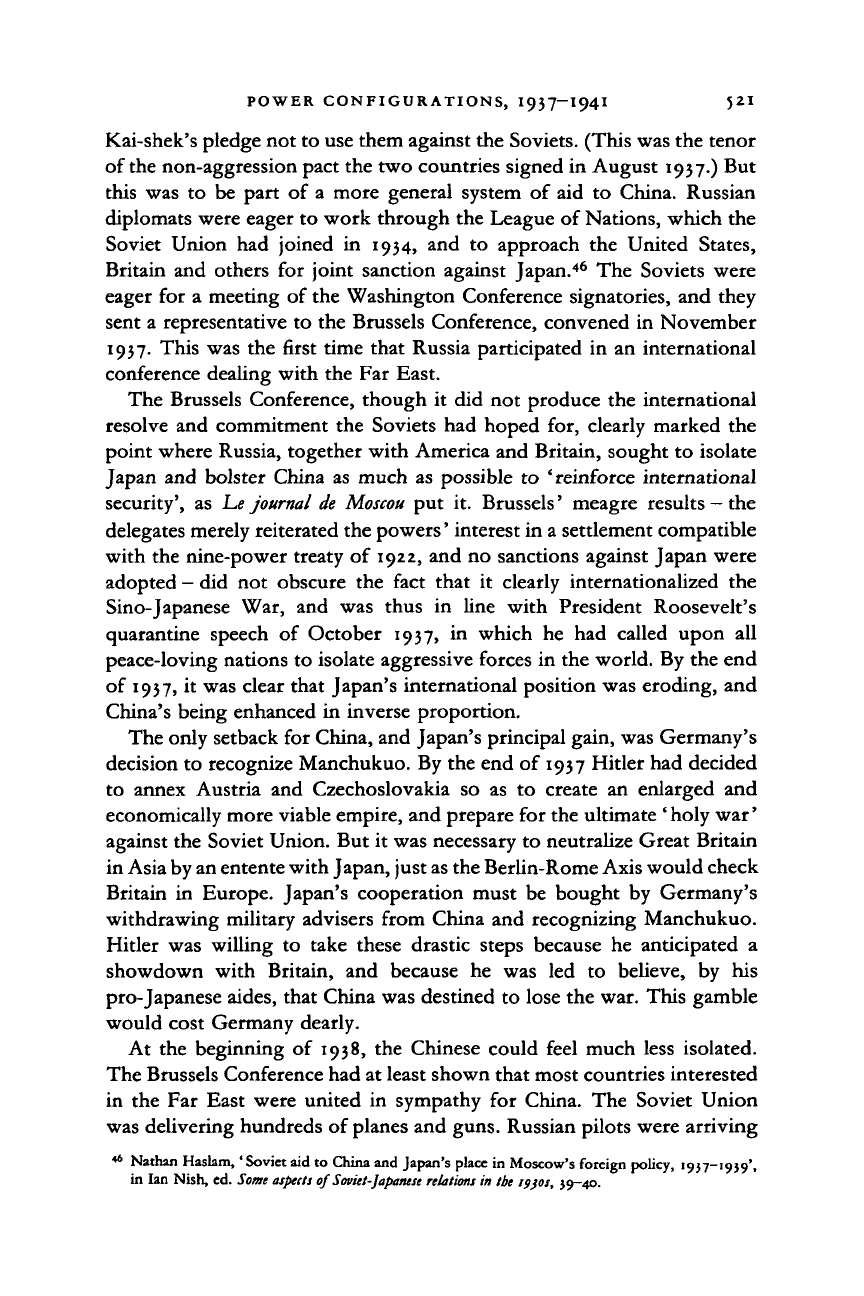
POWER CONFIGURATIONS, I937—I94I }2I
Kai-shek's pledge not to use them against the Soviets. (This was the tenor
of the non-aggression pact the two countries signed
in
August 1937.) But
this
was to be
part
of a
more general system
of aid to
China. Russian
diplomats were eager
to
work through the League
of
Nations, which
the
Soviet Union
had
joined
in 1934, and to
approach
the
United States,
Britain
and
others
for
joint sanction against Japan.
46
The
Soviets were
eager
for a
meeting
of
the Washington Conference signatories,
and
they
sent
a
representative
to the
Brussels Conference, convened
in
November
1937.
This
was the
first time that Russia participated
in an
international
conference dealing with
the Far
East.
The Brussels Conference, though
it did not
produce
the
international
resolve
and
commitment
the
Soviets
had
hoped
for,
clearly marked
the
point where Russia, together with America
and
Britain, sought
to
isolate
Japan
and
bolster China
as
much
as
possible
to
'reinforce international
security',
as
Le
journal de Moscou
put it.
Brussels' meagre results
—
the
delegates merely reiterated the powers' interest in a settlement compatible
with
the
nine-power treaty
of
1922,
and no
sanctions against Japan were
adopted
-
did
not
obscure
the
fact that
it
clearly internationalized
the
Sino-Japanese
War, and was
thus
in
line with President Roosevelt's
quarantine speech
of
October
1937, in
which
he had
called upon
all
peace-loving nations
to
isolate aggressive forces
in
the world. By the end
of 1937,
it
was clear that Japan's international position was eroding,
and
China's being enhanced
in
inverse proportion.
The only setback
for
China, and Japan's principal gain, was Germany's
decision
to
recognize Manchukuo. By the end
of
1937 Hitler had decided
to annex Austria
and
Czechoslovakia
so as to
create
an
enlarged
and
economically more viable empire, and prepare
for
the ultimate ' holy war'
against the Soviet Union. But
it
was necessary
to
neutralize Great Britain
in Asia by an entente with Japan, just as the Berlin-Rome Axis would check
Britain
in
Europe. Japan's cooperation must
be
bought
by
Germany's
withdrawing military advisers from China
and
recognizing Manchukuo.
Hitler
was
willing
to
take these drastic steps because
he
anticipated
a
showdown with Britain,
and
because
he was led to
believe,
by his
pro-Japanese aides, that China was destined
to
lose the war. This gamble
would cost Germany dearly.
At
the
beginning
of
1938,
the
Chinese could feel much less isolated.
The Brussels Conference had
at
least shown that most countries interested
in
the Far
East were united
in
sympathy
for
China.
The
Soviet Union
was delivering hundreds
of
planes and guns. Russian pilots were arriving
46
Nathan Haslam, 'Soviet aid
to
China and Japan's place
in
Moscow's foreign policy, 1937-1939',
in
Ian
Nish,
ed.
Some aspects
of
Soviet-Japanese
relations
in
the ipjos, 39-40.
Cambridge Histories Online © Cambridge University Press, 2008
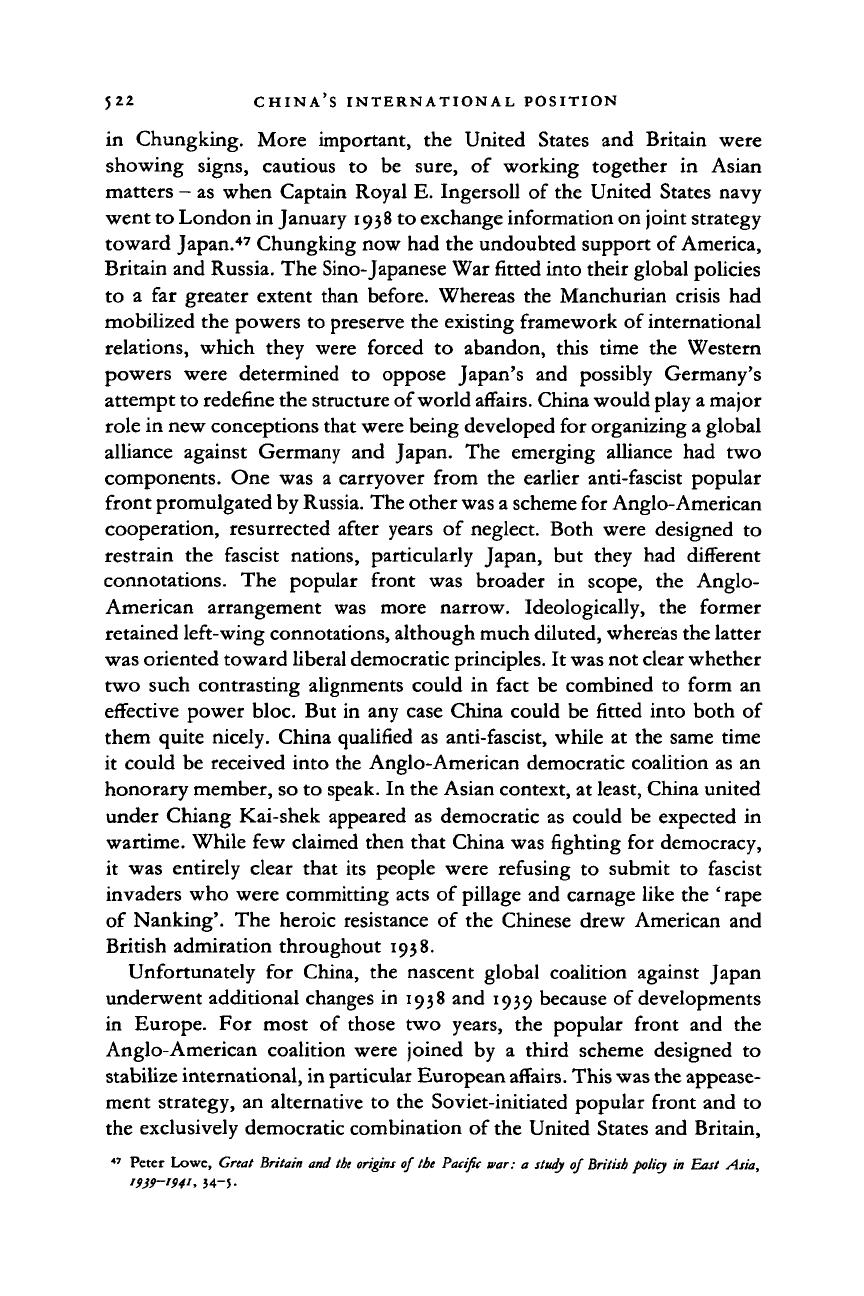
522 CHINA'S INTERNATIONAL POSITION
in Chungking. More important, the United States and Britain were
showing signs, cautious to be sure, of working together in Asian
matters - as when Captain Royal E. Ingersoll of the United States navy
went to London in January 1938 to exchange information on joint strategy
toward Japan.
47
Chungking now had the undoubted support of America,
Britain and Russia. The Sino-Japanese War fitted into their global policies
to a far greater extent than before. Whereas the Manchurian crisis had
mobilized the powers to preserve the existing framework of international
relations, which they were forced to abandon, this time the Western
powers were determined to oppose Japan's and possibly Germany's
attempt to redefine the structure of world affairs. China would play a major
role in new conceptions that were being developed for organizing a global
alliance against Germany and Japan. The emerging alliance had two
components. One was a carryover from the earlier anti-fascist popular
front promulgated by Russia. The other was a scheme for Anglo-American
cooperation, resurrected after years of neglect. Both were designed to
restrain the fascist nations, particularly Japan, but they had different
connotations. The popular front was broader in scope, the Anglo-
American arrangement was more narrow. Ideologically, the former
retained left-wing connotations, although much diluted, whereas the latter
was oriented toward liberal democratic principles. It was not clear whether
two such contrasting alignments could in fact be combined to form an
effective power bloc. But in any case China could be fitted into both of
them quite nicely. China qualified as anti-fascist, while at the same time
it could be received into the Anglo-American democratic coalition as an
honorary member, so to speak. In the Asian context, at least, China united
under Chiang Kai-shek appeared as democratic as could be expected in
wartime. While few claimed then that China was fighting for democracy,
it was entirely clear that its people were refusing to submit to fascist
invaders who were committing acts of pillage and carnage like the ' rape
of Nanking'. The heroic resistance of the Chinese drew American and
British admiration throughout 1938.
Unfortunately for China, the nascent global coalition against Japan
underwent additional changes in 1938 and 1939 because of developments
in Europe. For most of those two years, the popular front and the
Anglo-American coalition were joined by a third scheme designed to
stabilize international, in particular European affairs. This was the appease-
ment strategy, an alternative to the Soviet-initiated popular front and to
the exclusively democratic combination of the United States and Britain,
47
Peter Lowe, Great Britain and
tie
origins
of
tie
Pacific war:
a
study
of
British
policy
in
East Asia,
'9J9-W,
34-5-
Cambridge Histories Online © Cambridge University Press, 2008
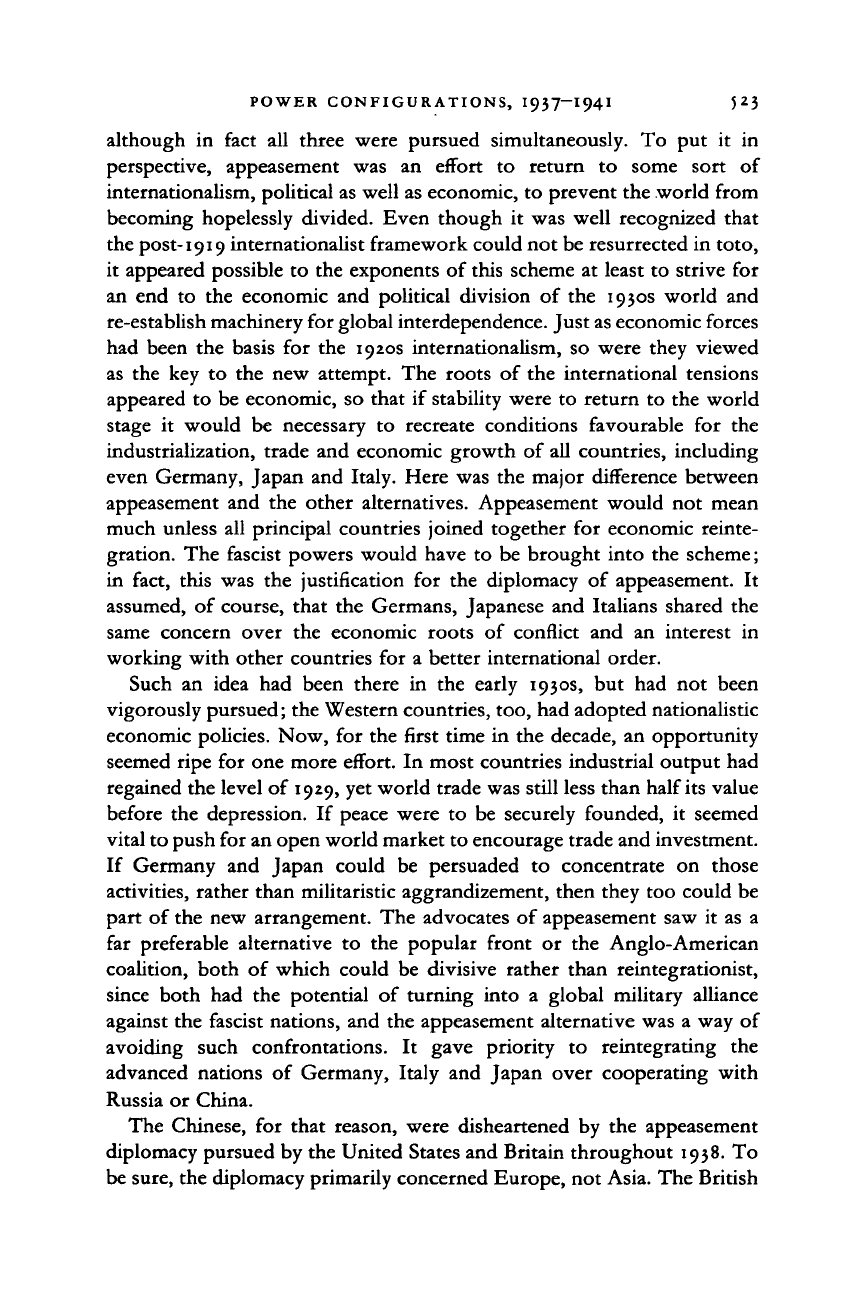
POWER CONFIGURATIONS, I937-I94I 523
although in fact all three were pursued simultaneously. To put it in
perspective, appeasement was an effort to return to some sort of
internationalism, political as well as economic, to prevent the world from
becoming hopelessly divided. Even though it was well recognized that
the post-1919 internationalist framework could not be resurrected in toto,
it appeared possible to the exponents of this scheme at least to strive for
an end to the economic and political division of the 1930s world and
re-establish machinery for global interdependence. Just as economic forces
had been the basis for the 1920s internationalism, so were they viewed
as the key to the new attempt. The roots of the international tensions
appeared to be economic, so that if stability were to return to the world
stage it would be necessary to recreate conditions favourable for the
industrialization, trade and economic growth of all countries, including
even Germany, Japan and Italy. Here was the major difference between
appeasement and the other alternatives. Appeasement would not mean
much unless all principal countries joined together for economic reinte-
gration. The fascist powers would have to be brought into the scheme;
in fact, this was the justification for the diplomacy of appeasement. It
assumed, of course, that the Germans, Japanese and Italians shared the
same concern over the economic roots of conflict and an interest in
working with other countries for a better international order.
Such an idea had been there in the early 1930s, but had not been
vigorously pursued; the Western countries, too, had adopted nationalistic
economic policies. Now, for the first time in the decade, an opportunity
seemed ripe for one more effort. In most countries industrial output had
regained the level of 1929, yet world trade was still less than half
its
value
before the depression. If peace were to be securely founded, it seemed
vital to push for an open world market to encourage trade and investment.
If Germany and Japan could be persuaded to concentrate on those
activities, rather than militaristic aggrandizement, then they too could be
part of the new arrangement. The advocates of appeasement saw it as a
far preferable alternative to the popular front or the Anglo-American
coalition, both of which could be divisive rather than reintegrationist,
since both had the potential of turning into a global military alliance
against the fascist nations, and the appeasement alternative was a way of
avoiding such confrontations. It gave priority to reintegrating the
advanced nations of Germany, Italy and Japan over cooperating with
Russia or China.
The Chinese, for that reason, were disheartened by the appeasement
diplomacy pursued by the United States and Britain throughout 1938. To
be sure, the diplomacy primarily concerned Europe, not Asia. The British
Cambridge Histories Online © Cambridge University Press, 2008
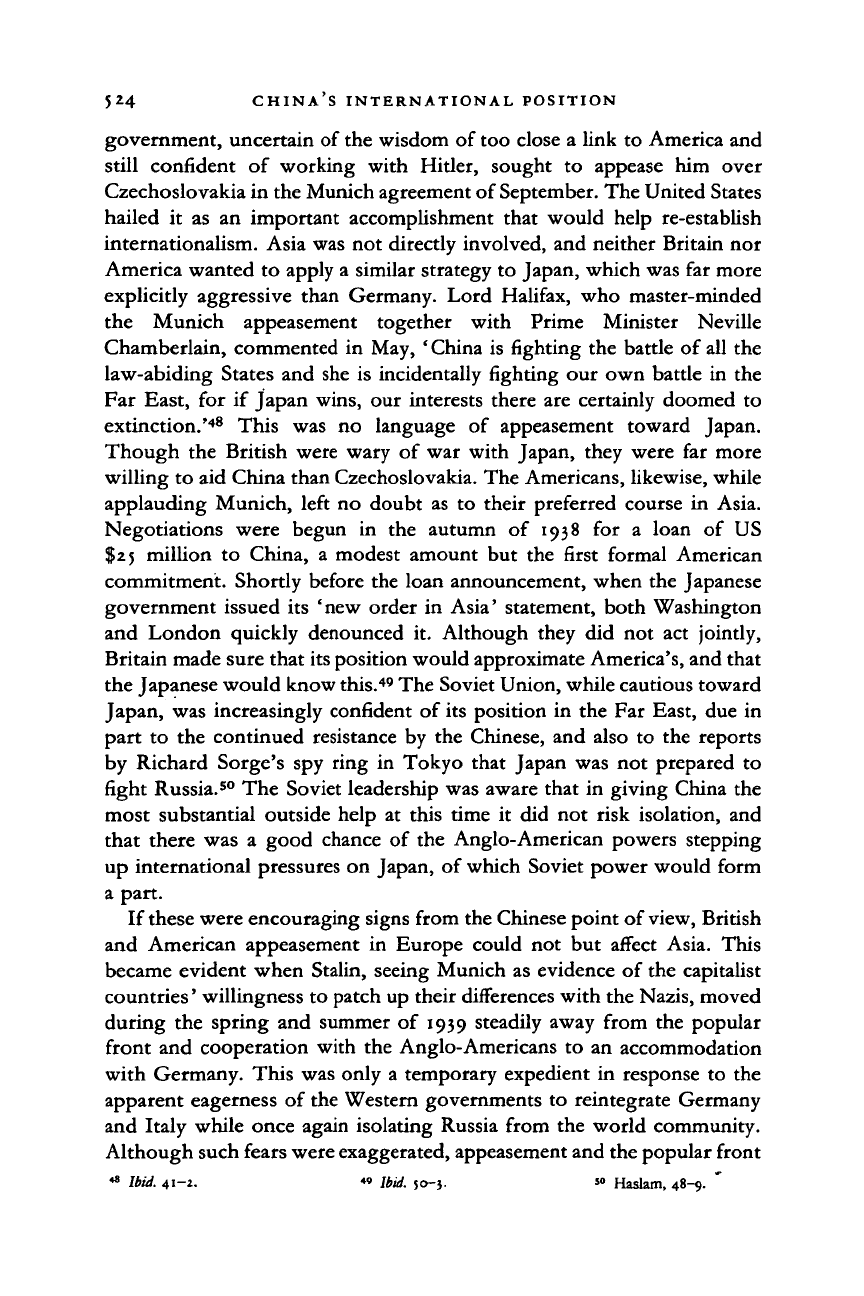
CHINA S INTERNATIONAL POSITION
government, uncertain of the wisdom of too close a link to America and
still confident of working with Hitler, sought to appease him over
Czechoslovakia in the Munich agreement of September. The United States
hailed it as an important accomplishment that would help re-establish
internationalism. Asia was not directly involved, and neither Britain nor
America wanted to apply a similar strategy to Japan, which was far more
explicitly aggressive than Germany. Lord Halifax, who master-minded
the Munich appeasement together with Prime Minister Neville
Chamberlain, commented in May, ' China is fighting the battle of all the
law-abiding States and she is incidentally fighting our own battle in the
Far East, for if Japan wins, our interests there are certainly doomed to
extinction.'
48
This was no language of appeasement toward Japan.
Though the British were wary of war with Japan, they were far more
willing to aid China than Czechoslovakia. The Americans, likewise, while
applauding Munich, left no doubt as to their preferred course in Asia.
Negotiations were begun in the autumn of 1938 for a loan of US
$25 million to China, a modest amount but the first formal American
commitment. Shortly before the loan announcement, when the Japanese
government issued its 'new order in Asia' statement, both Washington
and London quickly denounced it. Although they did not act jointly,
Britain made sure that its position would approximate America's, and that
the Japanese would know this.
49
The Soviet Union, while cautious toward
Japan, was increasingly confident of its position in the Far East, due in
part to the continued resistance by the Chinese, and also to the reports
by Richard Sorge's spy ring in Tokyo that Japan was not prepared to
fight Russia.
50
The Soviet leadership was aware that in giving China the
most substantial outside help at this time it did not risk isolation, and
that there was a good chance of the Anglo-American powers stepping
up international pressures on Japan, of which Soviet power would form
a part.
If these were encouraging signs from the Chinese point of
view,
British
and American appeasement in Europe could not but affect Asia. This
became evident when Stalin, seeing Munich as evidence of the capitalist
countries' willingness to patch up their differences with the Nazis, moved
during the spring and summer of 1939 steadily away from the popular
front and cooperation with the Anglo-Americans to an accommodation
with Germany. This was only a temporary expedient in response to the
apparent eagerness of the Western governments to reintegrate Germany
and Italy while once again isolating Russia from the world community.
Although such fears were exaggerated, appeasement and the popular front
48
Ibid.
41-2. «
Ibid.
50-5. so Haslam, 48-9.
Cambridge Histories Online © Cambridge University Press, 2008
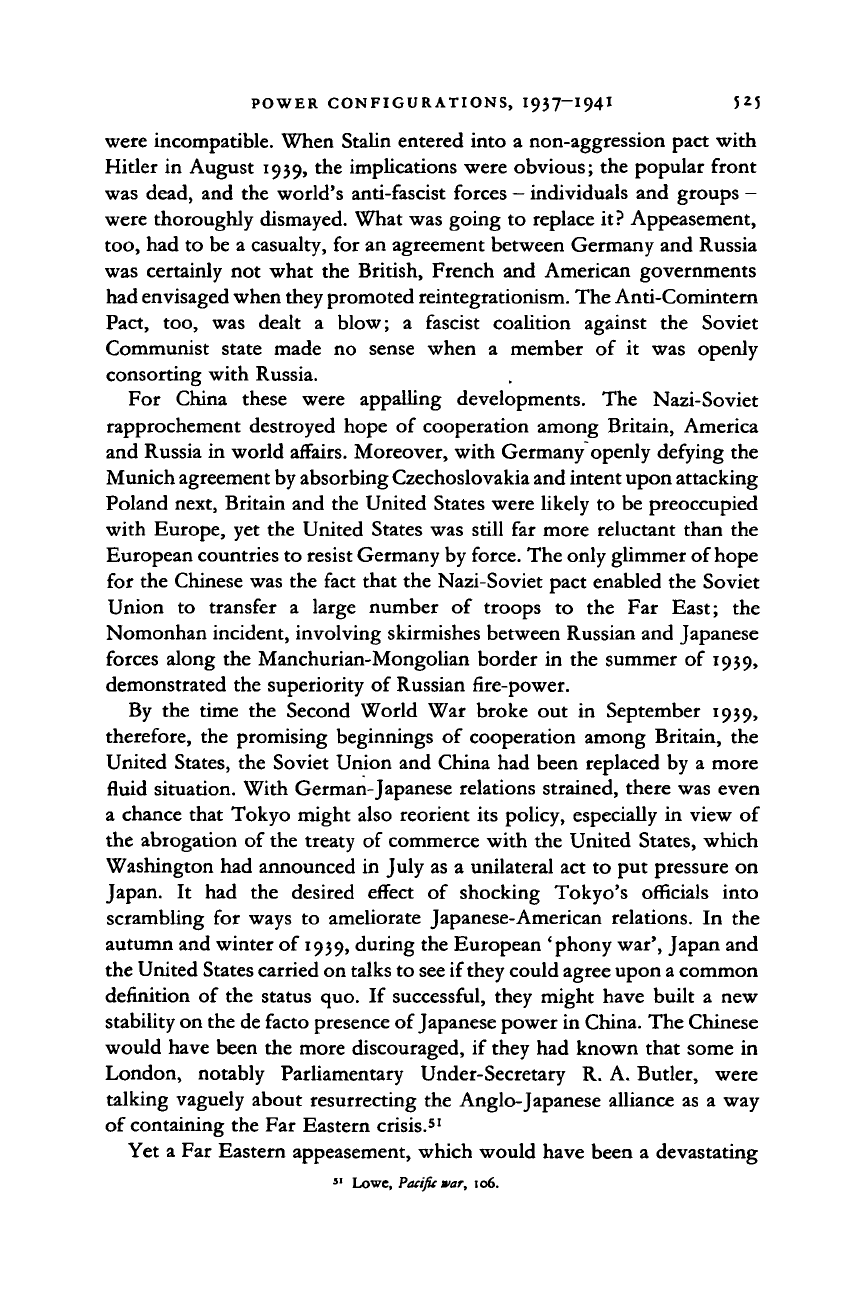
POWER CONFIGURATIONS, I937-194I 5
2
5
were incompatible. When Stalin entered into a non-aggression pact with
Hitler in August 1939, the implications were obvious; the popular front
was dead, and the world's anti-fascist forces - individuals and groups -
were thoroughly dismayed. What was going to replace it? Appeasement,
too,
had to be a casualty, for an agreement between Germany and Russia
was certainly not what the British, French and American governments
had envisaged when they promoted reintegrationism. The Anti-Comintern
Pact, too, was dealt a blow; a fascist coalition against the Soviet
Communist state made no sense when a member of it was openly
consorting with Russia.
For China these were appalling developments. The Nazi-Soviet
rapprochement destroyed hope of cooperation among Britain, America
and Russia in world affairs. Moreover, with Germany openly defying the
Munich agreement by absorbing Czechoslovakia and intent upon attacking
Poland next, Britain and the United States were likely to be preoccupied
with Europe, yet the United States was still far more reluctant than the
European countries to resist Germany by force. The only glimmer of hope
for the Chinese was the fact that the Nazi-Soviet pact enabled the Soviet
Union to transfer a large number of troops to the Far East; the
Nomonhan incident, involving skirmishes between Russian and Japanese
forces along the Manchurian-Mongolian border in the summer of 1939,
demonstrated the superiority of Russian fire-power.
By the time the Second World War broke out in September 1939,
therefore, the promising beginnings of cooperation among Britain, the
United States, the Soviet Union and China had been replaced by a more
fluid situation. With German-Japanese relations strained, there was even
a chance that Tokyo might also reorient its policy, especially in view of
the abrogation of the treaty of commerce with the United States, which
Washington had announced in July as a unilateral act to put pressure on
Japan. It had the desired effect of shocking Tokyo's officials into
scrambling for ways to ameliorate Japanese-American relations. In the
autumn and winter of
1939,
during the European 'phony war', Japan and
the United States carried on talks to see if they could agree upon a common
definition of the status quo. If successful, they might have built a new
stability on the de facto presence of Japanese power in China. The Chinese
would have been the more discouraged, if they had known that some in
London, notably Parliamentary Under-Secretary R. A. Butler, were
talking vaguely about resurrecting the Anglo-Japanese alliance as a way
of containing the Far Eastern crisis.
51
Yet a Far Eastern appeasement, which would have been a devastating
51
Lowe, Pacifit war, 106.
Cambridge Histories Online © Cambridge University Press, 2008
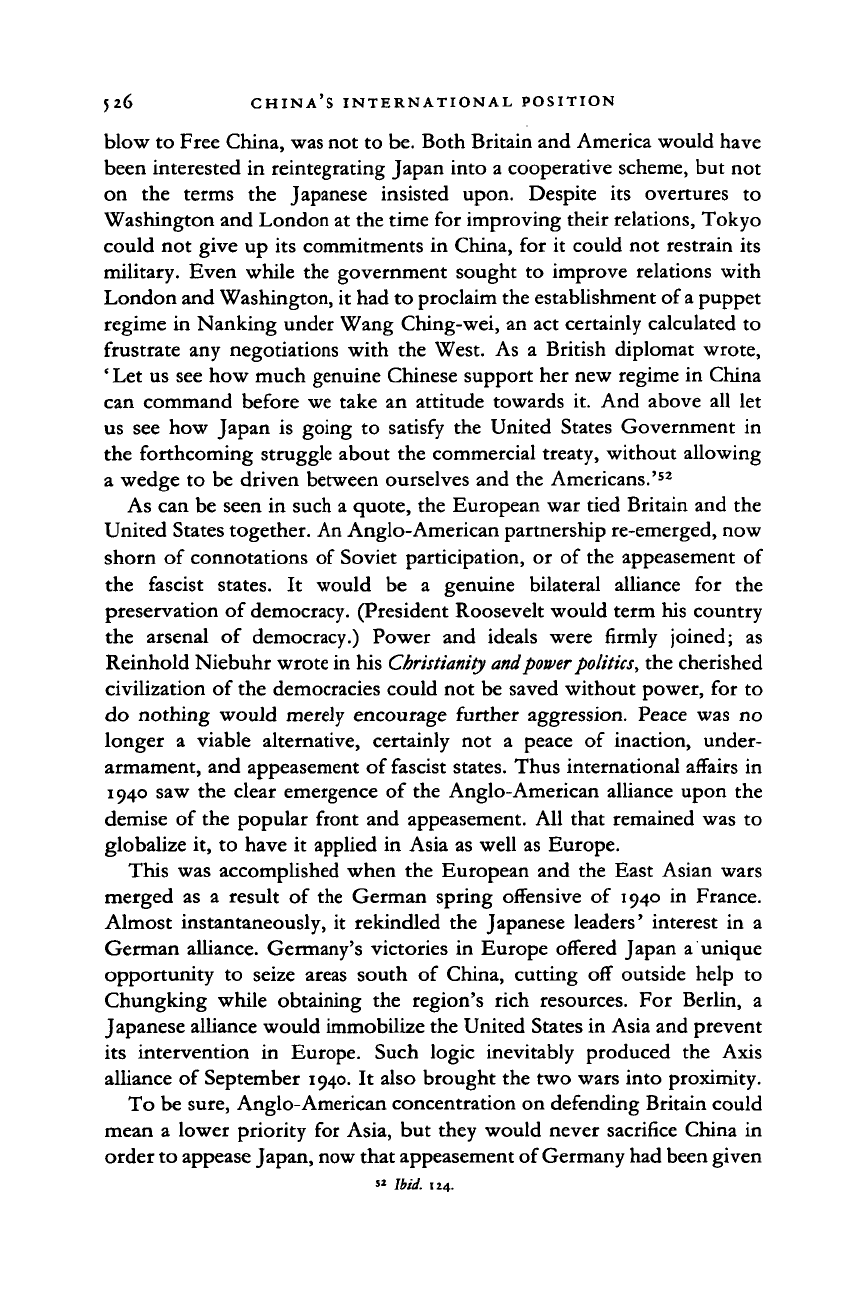
526
CHINA'S
INTERNATIONAL
POSITION
blow to Free China, was not to be. Both Britain and America would have
been interested in reintegrating Japan into a cooperative scheme, but not
on the terms the Japanese insisted upon. Despite its overtures to
Washington and London at the time for improving their relations, Tokyo
could not give up its commitments in China, for it could not restrain its
military. Even while the government sought to improve relations with
London and Washington, it had to proclaim the establishment of
a
puppet
regime in Nanking under Wang Ching-wei, an act certainly calculated to
frustrate any negotiations with the West. As a British diplomat wrote,
' Let us see how much genuine Chinese support her new regime in China
can command before we take an attitude towards it. And above all let
us see how Japan is going to satisfy the United States Government in
the forthcoming struggle about the commercial treaty, without allowing
a wedge to be driven between ourselves and the Americans.'
52
As can be seen in such a quote, the European war tied Britain and the
United States together. An Anglo-American partnership re-emerged, now
shorn of connotations of Soviet participation, or of the appeasement of
the fascist states. It would be a genuine bilateral alliance for the
preservation of democracy. (President Roosevelt would term his country
the arsenal of democracy.) Power and ideals were firmly joined; as
Reinhold Niebuhr wrote in his
Christianity
and power
politics,
the cherished
civilization of the democracies could not be saved without power, for to
do nothing would merely encourage further aggression. Peace was no
longer a viable alternative, certainly not a peace of inaction, under-
armament, and appeasement of fascist states. Thus international affairs in
1940 saw the clear emergence of the Anglo-American alliance upon the
demise of the popular front and appeasement. All that remained was to
globalize it, to have it applied in Asia as well as Europe.
This was accomplished when the European and the East Asian wars
merged as a result of the German spring offensive of 1940 in France.
Almost instantaneously, it rekindled the Japanese leaders' interest in a
German alliance. Germany's victories in Europe offered Japan a unique
opportunity to seize areas south of China, cutting off outside help to
Chungking while obtaining the region's rich resources. For Berlin, a
Japanese alliance would immobilize the United States in Asia and prevent
its intervention in Europe. Such logic inevitably produced the Axis
alliance of September 1940. It also brought the two wars into proximity.
To be sure, Anglo-American concentration on defending Britain could
mean a lower priority for Asia, but they would never sacrifice China in
order to appease Japan, now that appeasement of Germany had been given
»
Ibid. 124.
Cambridge Histories Online © Cambridge University Press, 2008
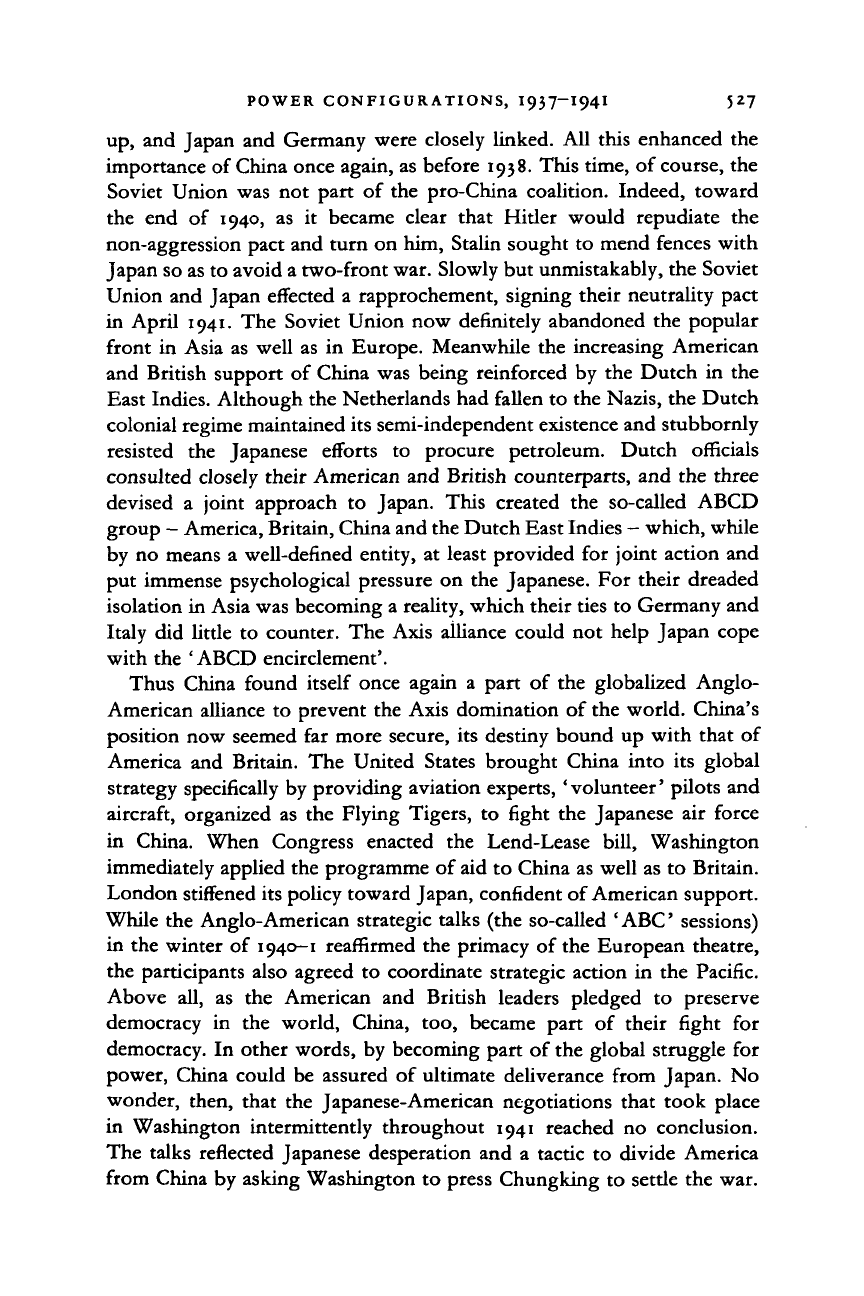
POWER CONFIGURATIONS, 1937-1941 527
up,
and Japan and Germany were closely linked. All this enhanced the
importance of China once again, as before 1938. This time, of course, the
Soviet Union was not part of the pro-China coalition. Indeed, toward
the end of 1940, as it became clear that Hitler would repudiate the
non-aggression pact and turn on him, Stalin sought to mend fences with
Japan so as to avoid a two-front war. Slowly but unmistakably, the Soviet
Union and Japan effected a rapprochement, signing their neutrality pact
in April 1941. The Soviet Union now definitely abandoned the popular
front in Asia as well as in Europe. Meanwhile the increasing American
and British support of China was being reinforced by the Dutch in the
East Indies. Although the Netherlands had fallen to the Nazis, the Dutch
colonial regime maintained its semi-independent existence and stubbornly
resisted the Japanese efforts to procure petroleum. Dutch officials
consulted closely their American and British counterparts, and the three
devised a joint approach to Japan. This created the so-called ABCD
group - America, Britain, China and the Dutch East Indies - which, while
by no means a well-defined entity, at least provided for joint action and
put immense psychological pressure on the Japanese. For their dreaded
isolation in Asia was becoming a reality, which their ties to Germany and
Italy did little to counter. The Axis alliance could not help Japan cope
with the 'ABCD encirclement'.
Thus China found itself once again a part of the globalized Anglo-
American alliance to prevent the Axis domination of the world. China's
position now seemed far more secure, its destiny bound up with that of
America and Britain. The United States brought China into its global
strategy specifically by providing aviation experts, 'volunteer' pilots and
aircraft, organized as the Flying Tigers, to fight the Japanese air force
in China. When Congress enacted the Lend-Lease bill, Washington
immediately applied the programme of aid to China as well as to Britain.
London stiffened its policy toward Japan, confident of American support.
While the Anglo-American strategic talks (the so-called 'ABC sessions)
in the winter of
1940—1
reaffirmed the primacy of the European theatre,
the participants also agreed to coordinate strategic action in the Pacific.
Above all, as the American and British leaders pledged to preserve
democracy in the world, China, too, became part of their fight for
democracy. In other words, by becoming part of the global struggle for
power, China could be assured of ultimate deliverance from Japan. No
wonder, then, that the Japanese-American negotiations that took place
in Washington intermittently throughout 1941 reached no conclusion.
The talks reflected Japanese desperation and a tactic to divide America
from China by asking Washington to press Chungking to settle the war.
Cambridge Histories Online © Cambridge University Press, 2008
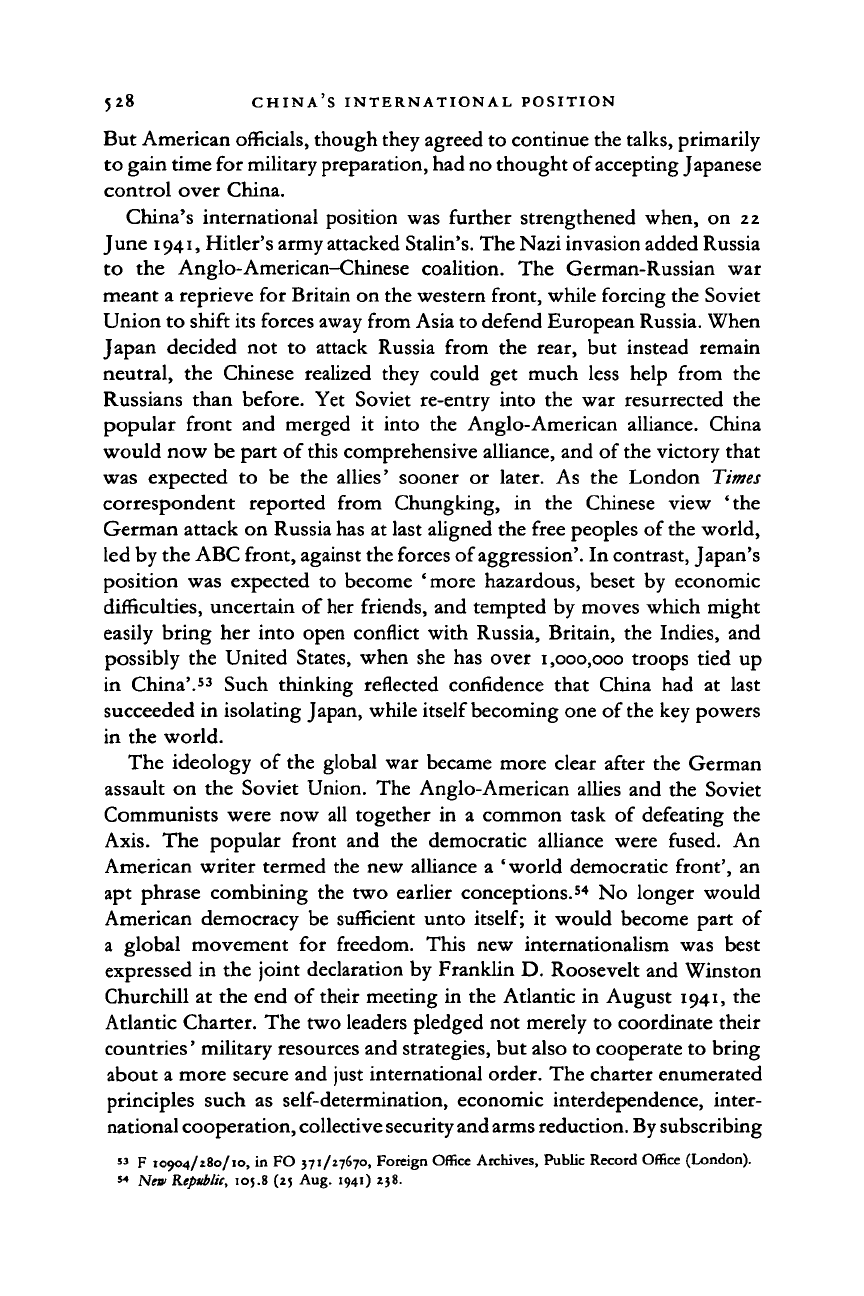
528 CHINA'S INTERNATIONAL POSITION
But American officials, though they agreed to continue the talks, primarily
to gain time for military preparation, had no thought of accepting Japanese
control over China.
China's international position was further strengthened when, on 22
June
1941,
Hitler's army attacked Stalin's. The Nazi invasion added Russia
to the Anglo-American-Chinese coalition. The German-Russian war
meant a reprieve for Britain on the western front, while forcing the Soviet
Union to shift its forces away from Asia to defend European Russia. When
Japan decided not to attack Russia from the rear, but instead remain
neutral, the Chinese realized they could get much less help from the
Russians than before. Yet Soviet re-entry into the war resurrected the
popular front and merged it into the Anglo-American alliance. China
would now be part of this comprehensive alliance, and of the victory that
was expected to be the allies' sooner or later. As the London Times
correspondent reported from Chungking, in the Chinese view 'the
German attack on Russia has at last aligned the free peoples of the world,
led by the ABC front, against the forces of aggression'. In contrast, Japan's
position was expected to become 'more hazardous, beset by economic
difficulties, uncertain of her friends, and tempted by moves which might
easily bring her into open conflict with Russia, Britain, the Indies, and
possibly the United States, when she has over
1,000,000
troops tied up
in China'.
53
Such thinking reflected confidence that China had at last
succeeded in isolating Japan, while itself becoming one of the key powers
in the world.
The ideology of the global war became more clear after the German
assault on the Soviet Union. The Anglo-American allies and the Soviet
Communists were now all together in a common task of defeating the
Axis.
The popular front and the democratic alliance were fused. An
American writer termed the new alliance a 'world democratic front', an
apt phrase combining the two earlier conceptions.
54
No longer would
American democracy be sufficient unto
itself;
it would become part of
a global movement for freedom. This new internationalism was best
expressed in the joint declaration by Franklin D. Roosevelt and Winston
Churchill at the end of their meeting in the Atlantic in August 1941, the
Atlantic Charter. The two leaders pledged not merely to coordinate their
countries' military resources and strategies, but also to cooperate to bring
about a more secure and just international order. The charter enumerated
principles such as self-determination, economic interdependence, inter-
national cooperation, collective security and arms reduction.
By
subscribing
53
F
10904/280/10,
in FO
371/27670, Foreign Office Archives, Public Record Office (London).
54
New
Republic,
105.8 (25 Aug. 1941) 238.
Cambridge Histories Online © Cambridge University Press, 2008
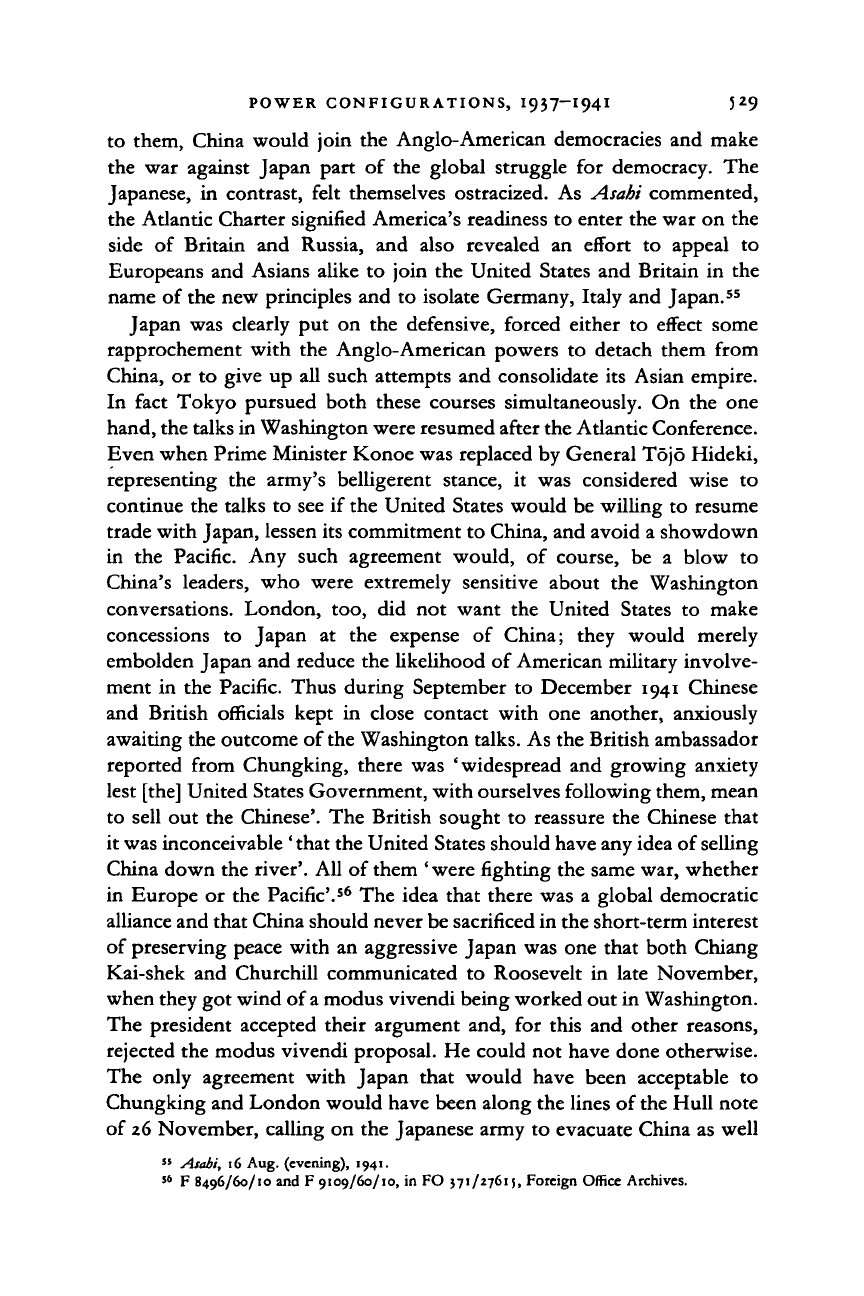
POWER CONFIGURATIONS, I937-I94I 529
to them, China would join the Anglo-American democracies and make
the war against Japan part
of
the global struggle
for
democracy.
The
Japanese,
in
contrast, felt themselves ostracized. As Asahi commented,
the Atlantic Charter signified America's readiness to enter the war on the
side
of
Britain
and
Russia,
and
also revealed
an
effort
to
appeal
to
Europeans and Asians alike
to
join the United States and Britain
in
the
name
of
the new principles and to isolate Germany, Italy and Japan.
ss
Japan was clearly
put on the
defensive, forced either
to
effect some
rapprochement with the Anglo-American powers
to
detach them from
China,
or to
give up all such attempts and consolidate its Asian empire.
In fact Tokyo pursued both these courses simultaneously.
On the
one
hand, the talks in Washington were resumed after the Atlantic Conference.
Even when Prime Minister Konoe was replaced by General Tojo Hideki,
representing
the
army's belligerent stance,
it
was considered wise
to
continue the talks to see
if
the United States would be willing to resume
trade with Japan, lessen its commitment to China, and avoid a showdown
in
the
Pacific.
Any
such agreement would,
of
course,
be a
blow
to
China's leaders, who were extremely sensitive about
the
Washington
conversations. London, too,
did not
want
the
United States
to
make
concessions
to
Japan
at the
expense
of
China; they would merely
embolden Japan and reduce the likelihood of American military involve-
ment
in
the Pacific. Thus during September
to
December 1941 Chinese
and British officials kept
in
close contact with one another, anxiously
awaiting the outcome of
the
Washington talks. As the British ambassador
reported from Chungking, there was 'widespread and growing anxiety
lest [the] United States Government, with ourselves following them, mean
to sell out the Chinese'. The British sought
to
reassure the Chinese that
it was inconceivable
'
that the United States should have any idea of selling
China down the river'. All of them 'were fighting the same war, whether
in Europe
or
the Pacific'.
s6
The idea that there was
a
global democratic
alliance and that China should never be sacrificed in the short-term interest
of preserving peace with an aggressive Japan was one that both Chiang
Kai-shek and Churchill communicated
to
Roosevelt
in
late November,
when they got wind of a modus vivendi being worked out in Washington.
The president accepted their argument and,
for
this and other reasons,
rejected the modus vivendi proposal. He could not have done otherwise.
The only agreement with Japan that would have been acceptable
to
Chungking and London would have been along the lines of the Hull note
of 26 November, calling on the Japanese army to evacuate China as well
u
Asabi, 16 Aug. (evening), 1941.
56
F
8496/60/10 and F 9109/60/10, in FO 571/27615, Foreign Office Archives.
Cambridge Histories Online © Cambridge University Press, 2008
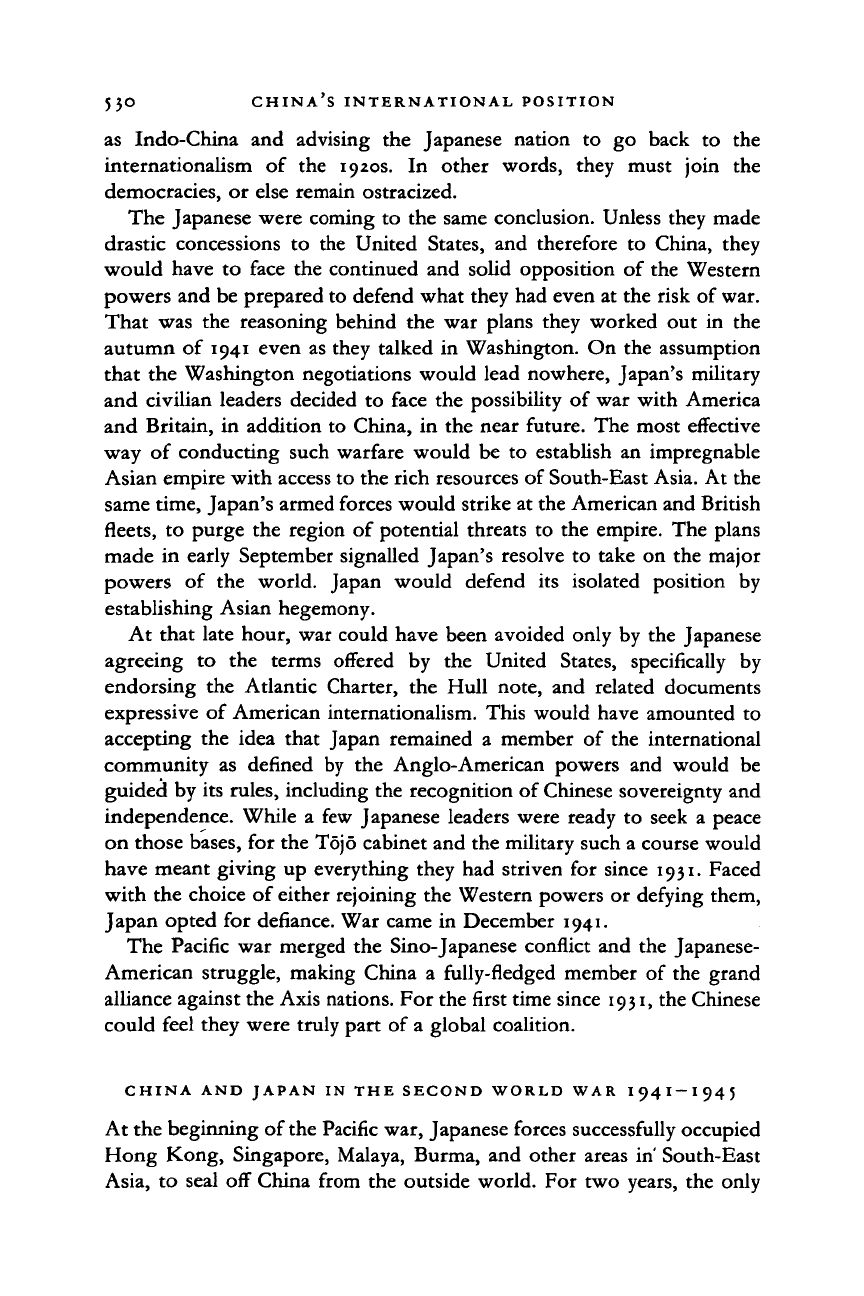
530 CHINA
S
INTERNATIONAL POSITION
as Indo-China
and
advising
the
Japanese nation
to go
back
to the
internationalism
of the
1920s.
In
other words, they must join
the
democracies,
or
else remain ostracized.
The Japanese were coming
to the
same conclusion. Unless they made
drastic concessions
to the
United States,
and
therefore
to
China, they
would have
to
face
the
continued
and
solid opposition
of the
Western
powers
and be
prepared
to
defend what they
had
even
at the
risk
of
war.
That
was the
reasoning behind
the war
plans they worked
out in the
autumn
of
1941 even
as
they talked
in
Washington.
On the
assumption
that
the
Washington negotiations would lead nowhere, Japan's military
and civilian leaders decided
to
face
the
possibility
of
war with America
and Britain,
in
addition
to
China,
in the
near future.
The
most effective
way
of
conducting such warfare would
be to
establish
an
impregnable
Asian empire with access
to
the rich resources
of
South-East Asia.
At the
same time, Japan's armed forces would strike
at
the American and British
fleets, to purge
the
region
of
potential threats
to the
empire.
The
plans
made
in
early September signalled Japan's resolve
to
take
on the
major
powers
of the
world. Japan would defend
its
isolated position
by
establishing Asian hegemony.
At that late hour,
war
could have been avoided only
by the
Japanese
agreeing
to the
terms offered
by the
United States, specifically
by
endorsing
the
Atlantic Charter,
the
Hull note,
and
related documents
expressive
of
American internationalism. This would have amounted
to
accepting
the
idea that Japan remained
a
member
of the
international
community
as
defined
by the
Anglo-American powers
and
would
be
guided
by
its rules, including
the
recognition
of
Chinese sovereignty and
independence. While
a few
Japanese leaders were ready
to
seek
a
peace
on those bases,
for the
Tojo cabinet
and the
military such
a
course would
have meant giving
up
everything they
had
striven
for
since 1931. Faced
with
the
choice
of
either rejoining
the
Western powers
or
defying them,
Japan opted
for
defiance.
War
came
in
December 1941.
The Pacific
war
merged
the
Sino-Japanese conflict
and the
Japanese-
American struggle, making China
a
fully-fledged member
of the
grand
alliance against the Axis nations. For the first time since
1931,
the Chinese
could feel they were truly part
of a
global coalition.
CHINA AND JAPAN IN THE SECOND WORLD WAR I941-I945
At the beginning
of
the Pacific war, Japanese forces successfully occupied
Hong Kong, Singapore, Malaya, Burma,
and
other areas in' South-East
Asia,
to
seal
off
China from
the
outside world.
For two
years,
the
only
Cambridge Histories Online © Cambridge University Press, 2008
